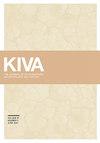利用颅骨和牙齿形态生物距离推断加利纳和陶丘普韦布洛人群的关系
IF 0.4
0 ARCHAEOLOGY
Kiva-Journal of Southwestern Anthropology and History
Pub Date : 2021-01-02
DOI:10.1080/00231940.2020.1866327
引用次数: 2
摘要
本文研究了来自美国西南部接触前的两个族群的生物学关系:新墨西哥州北部的加里纳族和新墨西哥州中部里约热内卢格兰德地区的陶土丘普韦布洛族。这两个群体存在于不同的时代,他们的社会条件和文化传统有很大的不同。我们通过测试距离隔离模型来检查关系的地理和时间结构。我们还测试了颅测量结果和牙科数据集之间是否存在相关性。包括来自11个地理和祖先语言群体的个体。牙齿和颅骨测量数据之间不存在相关性,但两种数据类型的结果显示了相似的关系模式。加利纳人可能在公元1200年代晚期搬到了中部的里约热内卢格兰德,拉普拉塔高速公路和陶器丘的人口相似。我们的结果不支持时间或地理距离模型的隔离。本文章由计算机程序翻译,如有差异,请以英文原文为准。
Inferring the Relationships of the Gallina and Pottery Mound Pueblo Populations Using Craniometric and Dental Morphological Biodistance
This article examines the biological relationships of two groups from the precontact Southwestern United States: the Gallina of Northern New Mexico and Pottery Mound Pueblo in the Middle Rio Grande region of New Mexico. These two groups existed at different times and differ considerably in their social conditions and cultural traditions. We examine geographic and temporal structure of relationships by testing an isolation by distance model. We also test whether correlations exist between results from craniometric and dental datasets. Included are individuals from eleven geographic and ancestral linguistic groupings. No correlations exist between the dental and craniometric data, but results for both data types revealed a similar pattern of relationships. The Gallina may have moved to the Middle Rio Grande in the late 1200s AD and the populations from La Plata Highway and Pottery Mound are similar. Our results do not support isolation by temporal or geographic distance models.
求助全文
通过发布文献求助,成功后即可免费获取论文全文。
去求助
来源期刊
CiteScore
0.70
自引率
33.30%
发文量
31

 求助内容:
求助内容: 应助结果提醒方式:
应助结果提醒方式:


